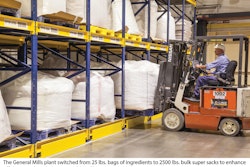
With food and beverage manufacturers continuously introducing SKUs to meet the demands of a more diverse customer base, supply chain decision makers are increasingly scrutinizing their warehouse storage layouts and racking systems. Supply chain managers look for ways to improve storage density while at the same time reduce product damage caused by their method of storage. Decision makers also have to consider safety and sustainability.
Much attention of late has focused on automated storage and retrieval systems (ASRS) and automatic guided vehicles (AVGs) which are giving supply chain managers more options to accomplish these goals. Automation, however, requires a large upfront investment that not all companies can afford. This article does not address automated warehouse systems since such ASRS and AVGs merit articles dedicated to those subjects that were featured in previous issues.
Static racking systems include numerous options. Drive-in racking, where the forklifts access the rack from an aisle, remains the dominant configuration in f&b manufacturing DCs. Pushback racking has rails installed at the front of each lane to enable pallets to move back and forth, supporting full pallet storage and retrieval. Single-deep pallet racking has low storage density but is good for storing fast changing SKUs that are retrieved on a first-in, first-out (FIFO) basis.
The most efficient rack configuration depends on how the available space in a warehouse matches up against the volume of inventory, the number of SKUs, how frequently the inventory turns, the lift truck equipment and labor capability. In some cases, the height of the warehouse also comes into play.
Goya Foods, Inc., the largest Hispanic-owned food company in the U.S., is opening a $127 million headquarters/distribution facility in Jersey City, N.J. The company has opted to install pallet-flow and pushback racks instead of the drive-in racks it was using in its previous facility, notes Peter Unanue, executive vice president. Pallet-flow racks will be on the ground level; pushback racks will be above and will replenish the pallet-flow racks. “It will allow us to keep an aisle more full more of the time,” Unanue says. “By utilizing pallet flow, we will separate replenishment aisles from picking aisles.”
The drive-in racks in the company’s previous facility were only partially utilized as they emptied, he notes.
Goya Foods considered different scenarios in designing its new distribution center, Unanue notes. He says the new racks are a bigger investment than the drive-in racks, but it will pay off over time.
The company considered installing multiple platforms and having an automated conveyor system, but this would have been a much bigger upfront investment. “The pallet flow system still allows us to increase our efficiency, availability and safety,” he says.
The company has the option of installing an automated conveyor system in the future, Unanue says. The existing racks would support multi-level platforms to support such a system.
Storage needs in flux
Many f&b product manufacturers are developing large, centralized distribution centers designed to ship both full pallets with a single SKU as well as partial pallets with a mix of multiple SKUs on the same pallet. This change in focus and demand from customers is causing a change in facility racking design. “Frequently, we will see facilities that are built with high-density unit load racking configured to handle the full pallets, combined with less dense rack to support layer picking and each picking operations to support the mixed SKU deliveries,” says John Krummell, president of Advance Storage Products, a rack manufacturer.
Warehouses that support ecommerce often use carton flow racks in which retail units can be taken out of a master carton to fulfill single-item purchases. Retail and wholesale DCs often use carton flow racks for general merchandise, health and beauty aids and specialty food items, which are slower moving SKUs, notes Marc Wulfraat, president of MWPVL International Inc., a Montreal, Canada-based supply chain consulting firm. Such warehouses often have carton flow racks at the ground level where employees can pick single items; the upper rack levels can store reserve pallets.
To address the various considerations, the Rack Manufacturers Institute (RMI) recently released “Considerations for the Planning and Use of Industrial Steel Storage Racks,” a detailed document offering guidelines for storage layout, racking installation, forklift considerations, aisle considerations, etc. RMI also issued guidelines for the assessment and repair or replacement of damaged racks.
The RMI developed the second document in recognizing that used racks continue to play a big role in today’s warehouses, says Shawn MacDonald, president of Joliet, Ill.-based Mac Rak, which specializes in rack repair and replacement. MacDonald notes that high employee turnover is a major safety issue in f&b warehouses; employees need to be trained how to operate forklifts and pallet jacks safely to not only prevent accidents, but to minimize damage to racks.
Supply chain managers have several well established storage solutions that have proven to be cost effective. There are two main types of systems: those designed for warehouses storing large volumes of a limited number SKUs, and those developed for smaller volumes of a larger number of SKUs. (See sidebar page XX.)
High density storage at less cost: flow rail
A new type of high-density storage media is called a flow-rail system which can be installed using existing post and beam or drive-in racking systems, Wulfraat says. Two or three rails need to be installed for the full depth of the rack structure which can be up to 10 positions in depth. The box-shaped rails are bolted onto the horizontal beams of back-to-back, single-deep racks. A chain within the box-shaped rail rotates clockwise and counterclockwise within the rail to allow pallets to be stored and retrieved.
A fundamental benefit of the flow-rail system is that there are no angles required as there are with a push-back or a flow-through rack. “You get much better use of the clear stacking height of your building and that can translate into higher storage capacity in some buildings,” Wulfraat says of the flow rail system.
Earth2O, a bottled water manufacturer based in Culver, Ore., recently installed a flow-rail rack system at its bottled water warehouse, notes Mike Peterson, vice president of operations. The company had been stacking cases of 6-, 12- and 24-unit shrink-wrapped packs of 12-oz., 16.9-oz., 20-oz. and 1-liter bottles on the floor. The Exglobe flow-rail system installed within the last few months has improved storage density, Peterson says.
Peterson says he investigated other racking options and determined the flow-rail system was the most cost efficient. He says there is no need for a forklift to enter an aisle to retrieve cases, which cuts down on labor, travel time and forklift-caused damage. “Every case is presented at the edge of the aisle,” he says. It doesn’t take any longer for the forklifts to stack the pallets than it did before, he adds. The pallets are stacked two and three levels high in the flow-rail system.
Earth2O tested a flow-rail rack test bay for eight weeks before installing the system. The warehouse now stores 1,500 pallets compared to the previous 450 pallets, Peterson says; seven to 10 days’ worth of inventory versus two or three days.
Seismic challenges for rack strength
This year’s earthquake on the West Coast generated interest in rack strength.
Hannibal Industries developed a rack that is designed to absorb a lot of force, such as that which can be caused by a seismic event. Hannibal Industries tested the TubeRack against a standard structural rack using wrecking ball simulating a forklift traveling two miles per hour. The forklift hit the racks direct, angled and head on.
Steve Rogers, vice president at Hannibal Industries, says the standard structural rack was not able to withstand the force of the forklift while the TubeRack was able to bounce back and yield minimal damage.
The TubeRack is designed to respond to a seismic event in a way that allows the rack to move with the motion rather than resisting it, Rogers says. He offers the comparison of a palm trees which moves with the wind. “This movement of the rack works to your advantage since it absorbs that energy,” he says.
The TubeRack can also feature a double-wide design provided by Twinlode, another manufacturer, that allows loading or unloading two pallets at a time while reducing handling costs, Rogers says. The Twinlode Gen 2 offers loading or unloading two pallets at a time while reducing handling costs. The tubular design also makes it possible to ship more within trucks and containers and ultimately reduces freight costs.
Some building codes on the West Coast are requiring larger foot plates, notes Kevin Rowles, president of Storage Solutions, a storage solution distributor and installer. Some building codes have increased pallet rack foot plate requirements from eight square inches to 12 square inches. “Every time the earth shakes, the plates get bigger,” he says. “With some of those seismic concerns, we’re having to be creative in how we approach these operations.”
The mezzanine option
Installing a mezzanine is another way f&b warehouses can add storage space, notes Shannon Salchert, marketing coordinator at Cubic Designs, which specializes in mezzanines. A mezzanine creates additional floor without necessarily removing existing floor space since racks can be installed beneath a mezzanine. The mezzanines are built off site, then installed in the location, leaving minimal disruption to any processes on the plant floor.
Mezzanines are often helpful in providing access to large conveyors and/or palletizers, Salchert says. This was the case at New Belgium Brewery, a Fort Collins, Colo. brewery that was looking to support a bottle conveyor and depalletizer.
New Belgium Brewery wanted to maximize its floor space while accommodating diverse elevations and multiple access points to new equipment. The custom steel mezzanine provided an overhead platform to support a bottle conveyor from a depalletizer to ground-level infeed of filling equipment.
The overhead platform changed elevation to accommodate the conveyor. The platform includes stairs, ladders and crossovers that provide access to the conveyor system. The platform wraps around the palletizer. The machine area is enclosed with safety guarding and cages.
As f&b product manufacturers, wholesalers and retailers respond to changing customer demands, supply chain managers need to consider what racking system or combination of systems will yield the greatest productivity, efficiently, safely and sustainably. The traditional racking systems continue to meet many of today’s warehouse needs, but new concepts are emerging.
For more information:
Advance Storage Products, 770-748-4860, advancestorageproducts.com
Cubic Designs, 800-826-7061, cubicdesigns.com
Exglobe, 1-855-884-0296 or 514-884-0296 , exglobe.ca
Hannibal Industries, 323-513-1200, e-hii.com
Mac Rak, 815-723-7400, macrak.com
MWPVL International, 514-482-3572, mwpvl.com
Orbis Corp., 800-890-7292, orbiscorporation.com
Power Automation Systems, 209-249-1616, powerautomationsystems.com
Rack Manufacturers Institute, 704-676-1190, mhi.org
Storage Solutions, 844-249-2060storage-solutions.com
Twinlode, 800-535-6719, twinlode.com
















